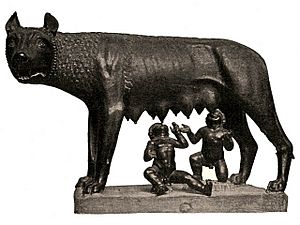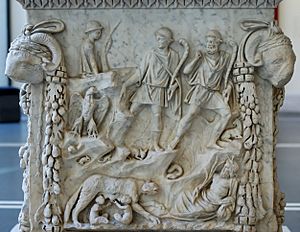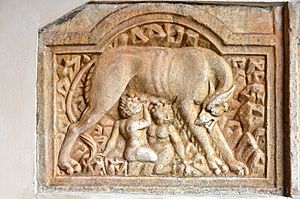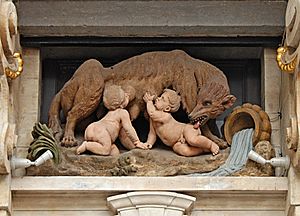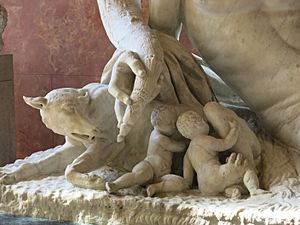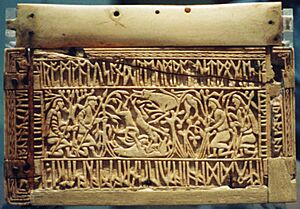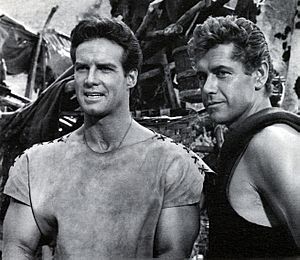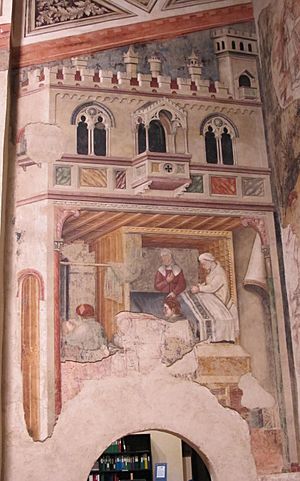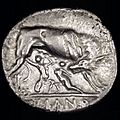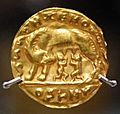Romulus and Remus facts for kids
In Roman mythology, Romulus and Remus were twin brothers who founded the city of Rome. Their mother was Rhea Silvia, and their father was the god Mars.
Contents
Their Birth and Early Life
Romulus and Remus were born in Alba Longa, an ancient city near where Rome would later be built. Their mother, Rhea Silvia, was the daughter of King Numitor Silvius of Alba Longa. But Numitor's brother, Amulius, took over the throne. To stop Rhea Silvia from having children who could become kings, Amulius made her a Vestal Virgin. This meant she was not allowed to marry or have children.
However, the god Mars visited Rhea Silvia, and she became pregnant with the twins. King Amulius was furious when he found out. He was afraid that Rhea's children would challenge his rule. So, he ordered the twins to be killed.
The babies were thrown into the Tiber River. But the river god Tiberinus saved them. A she-wolf found Romulus and Remus and nursed them in a cave called the Lupercal. Later, a shepherd named Faustulus adopted them and raised them as his own sons. They grew up herding sheep, not knowing they were actually princes.
As adults, they got caught in a fight between supporters of their grandfather Numitor and King Amulius. Remus was captured and taken to Alba Longa. Both his grandfather and the king started to suspect who he really was. Meanwhile, Romulus gathered people to help free his brother. During this time, the twins learned about their true past. They joined forces with their grandfather to put him back on the throne. Amulius was killed, and Numitor became king of Alba Longa again. After this, the twins decided to build their own city.
Some old stories say that a woodpecker brought the boys food when they were left alone in the wild. Also, in some versions, Remus was not captured. Instead, Romulus simply decided to get revenge on the Alban king for the wrongs done to his family. He went straight to the city with his supporters, killed Amulius, and gave the throne back to his grandfather.
Founding the City of Rome
When the two brothers returned to the seven hills, they disagreed about where to build their new city. Romulus wanted to build on the Palatine Hill, but Remus preferred the Aventine Hill. They decided to ask the gods for a sign. Each brother stood on his chosen hill. Remus saw six birds fly by first, but Romulus then saw twelve birds. Remus argued that he saw his birds first.
Even so, Romulus began building a wall around his city. Remus then jumped over the wall to make fun of his brother's work. Romulus became very angry and killed Remus. He felt sad about it later and buried Remus at Amulius's palace.
Romulus then went on to found the city of Rome. He created its rules, government, army, and religious traditions. He ruled for many years as Rome's first king.
Old Stories About Romulus and Remus
Historians still discuss different parts of this myth. Roman historians believe Rome was founded around 753 BC. However, the first known written story of Romulus and Remus appeared much later, in the late 3rd century BC. So, it's hard to know if the legend was always part of Rome's founding story or if it was added later.
Some of the ancient writers who mentioned Romulus and Remus include Livy, Plutarch, Ovid, and Virgil.
Most modern historians do not think Romulus and Remus were real people. But a few, like archaeologist Andrea Carandini, believe they might have been. Carandini found an old wall on the Palatine Hill that dates back to the mid-8th century BC. He calls it the Murus Romuli (Romulus's Wall).
Romulus and Remus in Movies and TV
- Romolo e Remo is a 1961 film starring Steve Reeves and Gordon Scott as the twin brothers.
- The First King: Birth of an Empire (Il Primo Re) is a 2019 Italian movie about Rome's founding. The actors in this film speak a reconstructed version of the old Latin language.
- Romulus is a 2020 Italian TV series by Matteo Rovere. It also uses the reconstructed Old Latin language.
Art Inspired by the Myth
The story of Romulus and Remus has inspired many artists throughout history.
Many paintings and sculptures show scenes from their legend, like the she-wolf nursing the twins or the brothers arguing over where to build Rome.
Interesting Facts About Romulus and Remus
- An old book called Origo gentis Romanae (The Origin of the Roman People) has a different version of the myth. In this story, Remus founds his own city called Remuria, and he lives longer than Romulus.
- Ancient pictures of the twins often show a shepherd, the she-wolf, and the twins under a fig tree. Sometimes, they show one or two birds.
- The twins and the she-wolf were shown on some of the earliest silver coins made in Rome.
- Ancient historians believed Romulus gave his name to the city. But most modern historians think the name Romulus was created from the name Rome, not the other way around.
- The historian Cassius Dio wrote about "another Romulus and Remus" and another Rome that was supposedly founded long ago in the same place.
Images for kids
See also
 In Spanish: Rómulo y Remo para niños
In Spanish: Rómulo y Remo para niños
- Asena, a similar legend about the origin of the Turks
- Castor and Pollux
- The Golden Bough, a story about Aeneas and Rome
- Greco-Roman world
- Hengist and Horsa, legendary brothers from an old British tale
- Lares
- Proto-Indo-European religion, §Twin Founders
- Romulus of Fiesole, an early saint who was also left in the wild and nursed by a she-wolf.
- Senius and Aschius, the legendary twin founders of Siena
- Cain and Abel, the first sons of Adam and Eve


